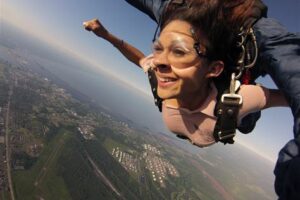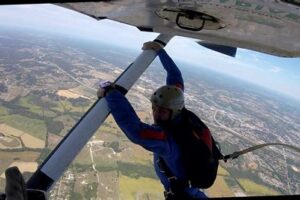Table of Contents
Learn how to earn your skydiving license with our comprehensive guide. Discover the step-by-step process, from tandem jumps to accelerated freefall training. Find out about safety precautions, equipment requirements, and the necessary skills to become a licensed skydiver. Start your thrilling journey towards obtaining your skydiving license today!
Skydiving, the thrilling and adrenaline-pumping activity that allows you to defy gravity, is a dream shared by many adventure enthusiasts. However, to truly experience the freedom of soaring through the air, one must acquire a skydiving license. Whether you are an aspiring daredevil or simply looking to conquer your fear of heights, obtaining a skydiving license is an exhilarating journey that requires dedication, training, and perseverance. So, if you are ready to embark on this remarkable adventure, let us guide you through the process of acquiring your very own skydiving license.
Introduction
Skydiving is an exhilarating sport that allows you to experience the thrill of freefalling from thousands of feet above the ground. If you are passionate about this adrenaline-pumping activity, you may be wondering how you can obtain a skydiving license. In this article, we will guide you through the process of getting your skydiving license step by step.
Research and Choose a Reliable Skydiving School
Before embarking on your journey towards obtaining a skydiving license, it is crucial to research and choose a reputable skydiving school. Look for schools that have certified instructors and excellent safety records. Reading reviews and testimonials from previous students can help you make an informed decision.
Schedule a Tandem Jump
Before starting your training, it is recommended to schedule a tandem jump with an experienced instructor. A tandem skydive allows you to experience the thrill of skydiving while attached to an instructor who will handle all the technical aspects. This experience will give you a taste of what to expect during your training.
Enroll in a First Jump Course
The next step is to enroll in a First Jump Course (FJC) offered by your chosen skydiving school. FJCs typically consist of a full day of ground training where you will learn about safety procedures, equipment usage, body positioning, and emergency protocols. This course is essential to ensure you have the necessary knowledge to jump safely.
Complete Static Line Jumps
After successfully completing the FJC, you will progress to static line jumps. In a static line jump, your parachute is deployed automatically as soon as you exit the aircraft. This allows you to focus on maintaining a stable body position and controlling your descent. You will typically need to complete several static line jumps before advancing further.
Progress to Accelerated Freefall (AFF)
Once you have gained confidence and proficiency in static line jumps, you will move on to the Accelerated Freefall (AFF) program. During AFF jumps, you will exit the aircraft with two instructors who will provide hands-on guidance and assistance. The AFF program focuses on developing your freefall skills, such as altitude awareness, stability, and maneuverability.
Master Freefall Skills
As you progress through the AFF program, you will gradually gain more independence and responsibility. You will learn various techniques, including turns, flips, and forward movement. It is important to practice and master these skills under the guidance of your instructors to ensure safe and controlled freefall experiences.
Pass Written and Practical Examinations
To obtain your skydiving license, you will need to pass both written and practical examinations. The written exam tests your knowledge of skydiving theory, safety procedures, and emergency protocols. The practical examination assesses your ability to perform different maneuvers and handle emergency situations effectively.
Log Sufficient Jump Hours
Apart from passing the examinations, you will also need to log a certain number of jump hours to be eligible for a skydiving license. The specific requirements may vary depending on your country or certification organization. These jump hours are crucial for gaining experience, building confidence, and demonstrating your competence in various skydiving scenarios.
Apply for Your Skydiving License
Once you have fulfilled all the necessary requirements, it is time to apply for your skydiving license. Contact the appropriate certification organization or governing body in your country to initiate the application process. They will guide you through the necessary paperwork and issue your well-deserved skydiving license.
Conclusion
Obtaining a skydiving license is an exciting and challenging journey that requires dedication, training, and practice. By following the steps outlined in this article, you can progressively work towards becoming a licensed skydiver. Remember to prioritize safety, listen to your instructors, and enjoy the incredible experiences that skydiving has to offer.
How To Get a Skydiving License: A Comprehensive Guide
Skydiving is an exhilarating and adrenaline-pumping activity that allows individuals to experience the thrill of freefalling through the sky. If you are passionate about skydiving and want to take your skills to the next level, obtaining a skydiving license is a necessary step. In this comprehensive guide, we will walk you through the process of obtaining a skydiving license, from choosing a reputable skydiving school to demonstrating proficiency and safety awareness.
1. Research and Choose a Reputable Skydiving School
The first step towards obtaining a skydiving license is to research and identify a reputable skydiving school that offers professional training programs. Look for schools with experienced instructors, positive reviews, and a proven track record of producing skilled skydivers. A reputable school will provide you with the necessary guidance and training to become a licensed skydiver.
2. Meet the Prerequisites
Before enrolling in a skydiving license program, ensure that you meet the prerequisites set by the skydiving school. These prerequisites may include a minimum age requirement, physical fitness criteria, and occasionally, a medical examination. Adhering to these prerequisites will ensure your eligibility for the program and enhance your overall safety during training and jumps.
3. Enroll in a Comprehensive Training Program
Enroll in a comprehensive skydiving training program that covers all the necessary theoretical and practical aspects of skydiving. The training program should include classroom sessions, practical exercises, and supervised jumps to help you acquire the knowledge and skills required to become a licensed skydiver. A comprehensive program will ensure that you receive thorough training and develop a strong foundation in skydiving.
4. Complete Ground School Training
Ground school training is an essential part of obtaining a skydiving license. This training covers the fundamental theoretical aspects of skydiving, including equipment knowledge, safety procedures, emergency protocols, and body positions. Take this training seriously as it forms the foundation of your skydiving education. Pay close attention to the teachings of experienced instructors and ask questions to clarify any doubts.
5. Master Accelerated Freefall (AFF) or Static Line Training
Choose between two popular methods of training – Accelerated Freefall (AFF) or Static Line Training. AFF allows you to experience freefall from the very first jump, while Static Line Training involves initially jumping attached to a static line that is automatically deployed, allowing you to practice canopy deployment and control. Consult with your instructors to determine which method suits your learning style and goals.
6. Complete Required Jumps and Training Levels
To obtain a skydiving license, you will need to complete a designated number of jumps and progress through different training levels. Each jump will introduce new skills and challenges, such as canopy control, freefall maneuvers, and landing techniques. Ensure that you fulfill the requirements at each level before proceeding to the next. Consistency and practice are key to mastering the necessary skills.
7. Pass Written Examinations
Skydiving licensing programs often include written examinations that assess your understanding of the theoretical concepts covered in ground school training. Study the provided material thoroughly and ensure that you pass these examinations to demonstrate your knowledge and readiness for solo jumps. Treat the examinations as opportunities to reinforce your understanding of important safety protocols and procedures.
8. Demonstrate Proficiency and Safety Awareness
Throughout the training program, and especially during your solo jumps, it is crucial to demonstrate proficiency and a strong commitment to safety. Follow all established protocols, adhere to safety guidelines, and maintain disciplined behavior. Your ability to consistently prioritize safety will contribute to your successful acquisition of a skydiving license. Remember that safety is paramount in skydiving, and responsible behavior is essential for both personal and collective well-being.
In conclusion, obtaining a skydiving license requires dedication, commitment, and a thorough understanding of the theoretical and practical aspects of skydiving. By researching and choosing a reputable skydiving school, meeting the prerequisites, enrolling in a comprehensive training program, completing ground school training, mastering the chosen training method, fulfilling required jumps and training levels, passing written examinations, and demonstrating proficiency and safety awareness, you can embark on an exciting journey towards becoming a licensed skydiver. So, take the leap and soar through the skies with the confidence and skills of a licensed skydiver!
In order to obtain a skydiving license, it is crucial to follow a structured and comprehensive training program that will equip you with the necessary skills and knowledge required for safe and successful skydiving experiences. Here are some key points to consider:
- Research and choose a reputable skydiving school: Look for a skydiving school that has a solid reputation, experienced instructors, and a strong emphasis on safety. This will ensure that you receive the highest quality training and guidance throughout your journey.
- Complete the Accelerated Freefall (AFF) course: The AFF course is a popular training method that allows beginners to learn to skydive in a relatively short period of time. It typically consists of a series of ground training sessions followed by several jumps accompanied by two instructors who provide hands-on guidance.
- Master the essential skills: During your training, you will learn crucial skills such as body positioning, canopy control, emergency procedures, and altitude awareness. It is important to practice these skills consistently and focus on mastering them to ensure your safety during each skydiving experience.
- Pass the written and practical exams: In addition to the practical training, you will need to pass both a written exam and a practical test to demonstrate your understanding of skydiving theory and your ability to apply it in real-life scenarios. These exams are designed to ensure that you have a solid foundation of knowledge and can make informed decisions while skydiving.
- Log the required number of jumps: To obtain your skydiving license, you will typically need to complete a certain number of jumps, ranging from 25 to 200, depending on the requirements set by the governing body in your country. These jumps will gradually increase in complexity and provide you with valuable experience.
- Consider additional training and specialization: Once you have obtained your skydiving license, you may choose to further enhance your skills by pursuing additional training or specializations such as formation skydiving, freeflying, or canopy piloting. These can open up new opportunities for exhilarating experiences and personal growth within the sport.
- Maintain a commitment to safety: Even after obtaining your skydiving license, it is crucial to prioritize safety at all times. Stay up-to-date with the latest safety regulations, continue to refine your skills through ongoing training, and always follow the guidance of experienced instructors and professionals in the field.
By following these steps and maintaining a disciplined approach to your training, you can work towards obtaining your skydiving license and embark on a thrilling journey that offers unmatched adrenaline rushes and breathtaking experiences in the sky.
Thank you for visiting our blog and taking the time to read our article on how to get a skydiving license. We hope that the information provided has been helpful in guiding you towards achieving your dream of becoming a licensed skydiver. In this closing message, we would like to summarize the key points discussed in the article and offer some final words of encouragement.
To start your journey towards obtaining a skydiving license, it is crucial to find a reputable skydiving school or training center. Look for facilities that are certified by recognized organizations such as the United States Parachute Association (USPA) or the International Bodyflight Association (IBA). These certifications ensure that the instructors and training programs meet industry standards and safety regulations.
Once you have selected a skydiving school, the next step is to enroll in a comprehensive training program. This typically includes both ground instruction and practical jumps. During the ground instruction, you will learn about the equipment used, safety procedures, body positioning, and emergency protocols. Transitioning from ground instruction to actual jumps will involve progressive skill-building exercises, starting with tandem jumps or static line jumps, and eventually progressing to solo jumps.
Throughout your training, it is important to be patient and dedicated. Skydiving is an exhilarating sport, but it requires discipline and a commitment to safety. Transitioning from a beginner to a licensed skydiver takes time and practice. Embrace the learning process, and don’t be discouraged by setbacks or challenges along the way. Remember, every jump is an opportunity to improve your skills and gain more experience.
In conclusion, obtaining a skydiving license is an achievable goal for anyone willing to put in the effort and dedication. Find a reputable training center, enroll in a comprehensive program, and embrace the learning process. With each jump, you will gain confidence and proficiency, bringing you one step closer to becoming a licensed skydiver. So, take the leap and embark on this thrilling adventure – the sky awaits!
Thank you once again for visiting our blog, and we wish you the best of luck in your skydiving journey. If you have any further questions or need more information, please feel free to reach out to us. Safe travels and blue skies!
Video How To Get Skydiving License
1. How do I get a skydiving license?
To obtain a skydiving license, you need to follow these steps:
- Start by finding a reputable skydiving school or center that offers training programs.
- Enroll in a basic skydiving course, often referred to as a First Jump Course (FJC), which typically lasts for a day or two.
- Complete the ground training, where you’ll learn about safety procedures, equipment usage, body position, and emergency protocols.
- Perform your first jump, usually a tandem jump with an instructor, to get hands-on experience while under supervision.
- After your initial jump, progress through a series of jumps known as Category Jumps, where you’ll gradually learn new skills and techniques.
- Accumulate the required number of jumps, usually around 25 to 30, depending on the country and certification system you’re following.
- Pass written exams and practical evaluations to demonstrate your knowledge and proficiency in various aspects of skydiving.
- Once you’ve completed all the necessary requirements, you will receive your skydiving license, allowing you to jump independently.
2. How long does it take to get a skydiving license?
The duration to obtain a skydiving license can vary depending on several factors, including individual abilities, weather conditions, and the availability of training slots. On average, it takes approximately 2 to 3 months for someone committed to regular training to earn their skydiving license. However, this timeline can be shorter or longer based on personal circumstances and external factors.
3. Can I get a skydiving license in one day?
No, it is not possible to obtain a skydiving license in just one day. Skydiving requires thorough training and experience to ensure safety and competency. The process typically involves completing a First Jump Course (FJC), which covers essential theoretical knowledge and practical skills. While you may be able to perform a tandem jump on your first day of training, obtaining a license will require additional jumps, training, and evaluations.
4. How much does it cost to get a skydiving license?
The cost of obtaining a skydiving license can vary depending on the location, the type of training program, and the number of jumps required. On average, you can expect to spend between $1,500 and $3,000 to complete the necessary training and earn your skydiving license. This cost usually includes instruction, equipment rental, jump fees, and licensing fees. It’s always advisable to inquire with specific skydiving schools or centers for accurate pricing information.
5. Do I need any prior experience to get a skydiving license?
No prior experience is necessary to obtain a skydiving license. Beginner skydivers are welcome to enroll in training programs designed for individuals with no previous skydiving knowledge. These programs provide comprehensive ground training and progression through various jumps, allowing you to develop the necessary skills and experience under professional guidance.






